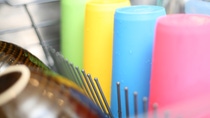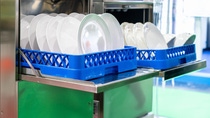Media
New rinse aid helps plastic dry better, faster during industrial cleaning
BASF develops a surfactant that reduces spotting and filming on plastic dishware.

Did you know that cleanliness is the number one reason a customer might return to an establishment?
That is the cause why 92 percent of consumers decide whether they become a repeat customer. In fact, 9 in 10 agree that they are more likely to have an overall negative opinion of an independent business if the public spaces are not clean, according to the 2017 Consumer Cleaning Insights Survey released by Proctor & Gamble.
Now imagine if you work in industrial cleaning—a restaurant or a cafeteria—and you’ve got hundreds of dishes and cups to wash in a very short time. Time is money in this environment and every second counts. The water used is very hot and the chemistry is strong; however, the water doesn’t rinse off quickly enough, leaving residual beads on the cups. You must physically remove (dry or wipe) the water that does not come off on its own.
To get that water removal process moving faster, BASF has added a little bit of chemistry to the rinse to prevent having to manually remove the water residue. This chemistry is called Plurafac LF RA-P. The company launched this rinse-aid additive in North America, and it was developed specifically for plastic surfaces and plastic dishware.
Plastic dishes absorb less heat than other materials, which in turn leads to less water evaporation on the surface. This action causes increased spotting and filming on plastic dishes.

BASF tested the ingredient on plastic plates, tumblers, trays and cups. The company showed lower spotting and filming on plastics in industrial and institutional wash applications compared to washing and rinsing with conventional chemistries.
“Being a surfactant, Plurafac LF RA-P changes the interaction between the water and the dish—and it is optimized for helping water run off plastics more easily for fast drying,” said Michael Capracotta, Technical Manager, Home Care and I&I, BASF North America.
In addition to reducing spotting, the rinse aid also uses lower self-foaming, a desirable trait for washing action in dishwashers, and saves energy with faster drying times—60 seconds for institutional cleaning compared to the traditional one hour of cleaning at home. It also enables higher soil load and minimizes manual drying labor.
“It prevents the spots from showing up and it expedites the rinsing process. This is a great cost and energy saver for industrial blow dryers,” Capracotta added.
While most rinse aids are made for glass, they have not been optimized for plastic—until now. Plurafac LF RA-P is not only made for plastic cleaning per se, it is also waste-friendly, since it extends the shelf life of the material. Plastics can be reused multiple times now and not merely discarded because they’re spotted, contributing to the company's sustainability goals of reducing plastic waste.
“The industry standard for spotting has been glass—everyone competes to make drinking glasses look spotless. But when it comes to plastic, we’ve found a neat and sustainable niche,” Capracotta concluded.
Published by Anna Spiewak.
For media inquiries or to repurpose this article, please contact Lisa Brown.